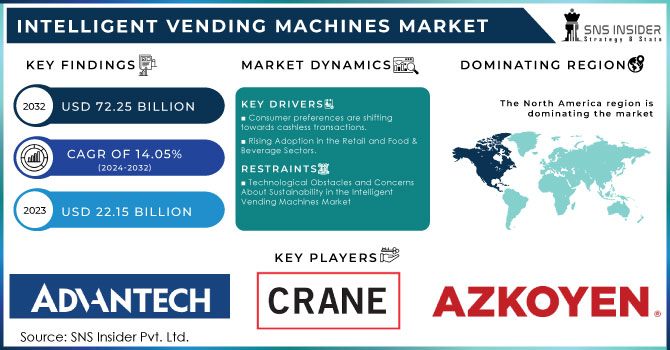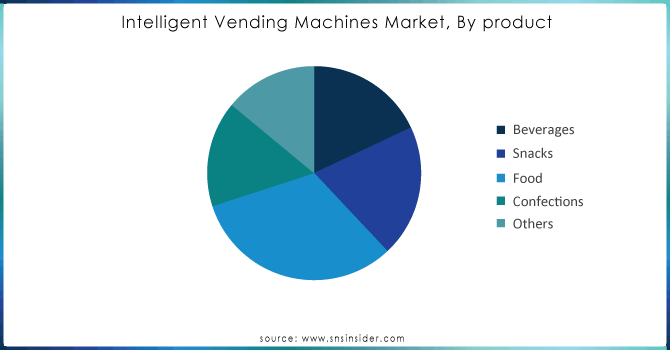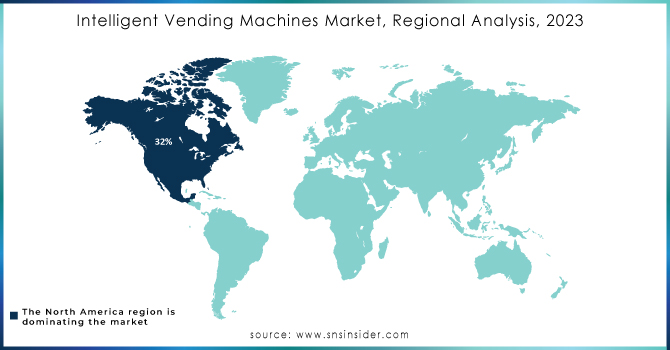Intelligent Vending Machines Market Scope & Overview:

To get more information on Intelligent Vending Machines Market - Request Free Sample Report
The Intelligent Vending Machines Market size was valued at USD 22.15 billion in 2023 and is expected to reach USD 72.25 billion by 2032 and grow at a CAGR of 14.05% over the forecast period 2024-2032.
The intelligent vending machines market is experiencing substantial growth due to technological advancements and shifts in consumer habits. The integration of advanced technologies like AI, IoT, and data analytics is mostly responsible for this change, allowing vending machines to offer customized experiences, boost efficiency, and attract tech-savvy customers. The vending machine sector in the United States is a notable part of the larger convenience market, producing more than USD 23 billion in yearly earnings. With around 5 million vending machines located throughout the nation, these machines can be frequently seen in schools, offices, and public areas. Snack and drink vending machines have a strong presence in the market, making up approximately 60% of the total. Other variations include machines that offer hot meals, fresh products, as well as non-food items such as electronics and personal care products. More than 10 million Americans use vending machines every day, typically spending between USD 1.50 to USD 2.50 per transaction. Vending machines are especially favored by young people and city residents, as they now offer cashless payment methods like credit/debit cards and mobile payments, making them even more popular.
Furthermore, intelligent vending machines have become appealing to businesses due to their capability to analyze consumer preferences and adjust to evolving demands. These machines can provide personalized product suggestions and improve inventory control by gathering data on buying habits and preferences. This approach based on data not only improves the customer experience but also aids in decreasing waste and boosting profitability for businesses. For example, vending machines in busy places like airports and malls can be filled with items that are popular among the particular groups of people who visit those areas.
Market Dynamics
Drivers
- Consumer preferences are shifting towards cashless transactions.
The quick progress in technology is a major catalyst for the Intelligent Vending Machines Market. With the growing trend towards cashless transactions among consumers, businesses are pushed to implement creative solutions to accommodate these changing needs. Smart vending machines, with cutting-edge payment options, are leading the way in this change, providing a smooth, cashless process that meets the demands of today's customers. The merging of contactless payment options like NFC and mobile payment systems enables users to quickly and securely make transactions with their smartphones or contactless cards. This technology not just improves convenience but also matches the increasing demand for sanitary and effective payment choices, especially amid health worries in the COVID-19 outbreak. For instance, businesses such as Byte Foods and VendSmart have integrated advanced payment systems into their vending machines, allowing customers to make payments through mobile apps or digital wallets. These machines also come equipped with real-time inventory monitoring and analysis, which helps improve stock levels and guarantees that in-demand products are consistently in stock.
- Rising Adoption in the Retail and Food & Beverage Sectors.
Intelligent vending machines in the retail industry offer a distinctive approach to interact with customers and offer them a customized shopping experience. Retailers have the ability to utilize these machines in order to provide customized deals and discounts by analyzing customer information. The machines can serve as an extra sales outlet, enabling retailers to access customers in areas where opening a large store may not be practical. Smart vending machines can also act as a hassle-free option for clients who want to buy items quickly. These machines can offer consumers a diverse selection of products, including snacks, beverages, beauty items, and electronics. By strategically placing vending machines, retailers can enhance their brand exposure and boost their sales. Intelligent vending machines are gaining popularity in the food & beverage industry because they can provide fresh, healthy, and customizable options. For instance, certain machines come with the ability to make fresh salads, smoothies, or coffee whenever needed, meeting the increasing need for healthy and convenient food choices.
Restraints
- Technological Obstacles and Concerns About Sustainability in the Intelligent Vending Machines Market
The Intelligent Vending Machines (IVM) market encounters major obstacles due to technological constraints and sustainability issues, impeding extensive acceptance. One of the main challenges in technology is incorporating advanced functionalities such as AI, IoT, and cashless payment systems into vending machines. These technologies need strong infrastructure, like dependable internet access and sophisticated software, which can be expensive and difficult to set up, especially in remote or underdeveloped regions. In addition, upkeep of the software and hardware needed for these advanced functions typically requires frequent updates and expert technical assistance, increasing operational expenses. In the retail sector, it can be difficult to implement IVMs with advanced features such as AI-driven product recommendations and real-time inventory management due to the requirement of frequent software updates and energy-intensive operations. As businesses work towards combining technological progress with eco-friendly practices, these challenges act as a significant barrier to the market's expansion, necessitating creative solutions to be able to move forward.
Market Segmentation
By Product
The food segment dominated in 2023 with a market share of 32%. Intelligent vending machines have revolutionized the food industry by combining technology and convenience in ways that traditional vending machines never could. These advanced machines offer a range of features designed to enhance the consumer experience and streamline operations for businesses. At their core, intelligent vending machines utilize a variety of technologies, such as IoT sensors, AI, and touchless interfaces, to provide a more interactive and efficient service. One of the key advancements in intelligent vending machines is their ability to offer a diverse range of food options.
The snacks sector is experiencing the most rapid growth during 2024-2032. This expansion is driven by the rising need for convenient and nutritious snack choices such as granola bars, nuts, and protein snacks. With consumers becoming increasingly health-conscious, smart vending machines that provide nutritional details and permit personalized snack choices are gaining popularity. Mondelez International and Kellogg's are using smart vending machines to increase their presence, especially in office buildings, fitness centers, and schools.

Need any customization research on Intelligent Vending Machines Market - Enquiry Now
By Application
The manufacturing sector led the market with a 38% market share in 2023. This prevalent dominance is a result of vending machines being widely used in industrial environments to distribute necessary tools, safety equipment, and supplies, ultimately improving operational effectiveness. Intelligent vending machines in manufacturing facilities improve inventory management and decrease downtime by giving employees instant access to required items. Businesses such as Fastenal have installed these machines to oversee inventory and cut down on operational expenses.
The commercial malls and retail stores segment is accounted to have a faster growth rate during 2024-2032. The rise is due to more consumers wanting self-service options and the convenience these machines offer in retail settings. Smart vending machines found in shopping malls and retail outlets provide a variety of items, including snacks and electronics, appealing to modern customers who appreciate fast and convenient purchases. Corporations such as Coca-Cola have employed smart vending machines in stores to offer personalized product suggestions and discounts tailored to customer tastes.
Regional Analysis
North America led the market in 2023 with a 32% market share, due to the fast uptake of innovative technologies and a strong retail infrastructure. The leading countries in the use of smart vending machines in sectors like retail, healthcare, and transportation are the U.S. and Canada. Consumers are driving the demand with their growing favor for contactless payment choices and personalized interactions. For example, Crane Merchandising Systems provides smart vending machines that come with telemetry systems, improving inventory control and live monitoring. Furthermore, Cantaloupe Inc. offers mobile payment options that are linked with vending machines, enabling smooth transactions and improved interaction with customers.
Asia-Pacific is experiencing the highest growth rate during the forecast period in the intelligent vending machines market, due to fast urbanization, rising disposable incomes, and a population adept at technology. Nations such as China, Japan, and South Korea are leading the way in this expansion, focusing heavily on smart city projects and digital payments. The area's development is additionally aided by the growth of retail and transportation industries, as smart vending machines provide ease and a diverse selection of items. For instance, Fuji Electric provides vending machines with touchless technology and instant data analysis, meeting the increasing need for cleanliness and productivity.

Key Players
The major key players are Crane Co, Advantech Co. Ltd., Azkoyen Group, FAS International S.p.A, Bianchi Vending Group S.p.A, Rhea Vendors Group, N&W Global Vending S.p.A, Westomatic Vending Services Ltd, Seaga, Jofemar, Sanden Corp and other players
RECENT DEVELOPMENT
-
In February 2024, Fuji Electric improved its vending machines. A new series of machines boasts advanced energy-saving technology that learns the best consumption parameters making them optimal with the help of AI. In general, power consumption is reduced by up to 20%
-
In September 2023, Azkoyen Group, announced a new line of vending machines that improves hygiene. To be more precise, it is a touchless vending machine that allows a customer to use their smartphone for choosing and paying for a product.
| Report Attributes | Details |
| Market Size in 2023 | USD 22.15 Billion |
| Market Size by 2032 | USD 72.25 Billion |
| CAGR | CAGR of 14.05% From 2024 to 2032 |
| Base Year | 2023 |
| Forecast Period | 2024-2032 |
| Historical Data | 2020-2022 |
| Report Scope & Coverage | Market Size, Segments Analysis, Competitive Landscape, Regional Analysis, DROC & SWOT Analysis, Forecast Outlook |
| Key Segments | • By Product(Beverages, Snacks, Food, Confections, Others) • By Application (Manufacturing, Commercial Malls & Retail Stores, Offices, Educational Institutes, Others) |
| Regional Analysis/Coverage | North America (US, Canada, Mexico), Europe (Eastern Europe [Poland, Romania, Hungary, Turkey, Rest of Eastern Europe] Western Europe] Germany, France, UK, Italy, Spain, Netherlands, Switzerland, Austria, Rest of Western Europe]), Asia Pacific (China, India, Japan, South Korea, Vietnam, Singapore, Australia, Rest of Asia Pacific), Middle East & Africa (Middle East [UAE, Egypt, Saudi Arabia, Qatar, Rest of Middle East], Africa [Nigeria, South Africa, Rest of Africa], Latin America (Brazil, Argentina, Colombia Rest of Latin America) |
| Company Profiles | Crane Co, Advantech Co. Ltd., Azkoyen Group, FAS International S.p.A, Bianchi Vending Group S.p.A, Rhea Vendors Group, N&W Global Vending S.p.A, Westomatic Vending Services Ltd, Seaga, Jofemar, Sanden Corp |
| Key Drivers |
• Consumer preferences are shifting towards cashless transactions • Rising Adoption in the Retail and Food & Beverage Sectors. |
| Market Restraints |
• Technological Obstacles and Concerns About Sustainability in the Intelligent Vending Machines Market |

